|

Memorial
Marker at Mount Nebo
Mount Nebo is located in
the modern day country of Jordan (east of the Jordan River). Though
part of the territory given to ancient Israel by God, it did not
remain under Israeli control for long portions of Biblical history.
Its primary claim to fame comes from the book of Deuteronomy, as the
place where God told Moses to go to die. God had told Moses that he
was not going to be allowed to cross of the Jordan River, into the
main portion of the Promised Land, due to his earlier sin in the
Sinai wilderness at the beginning of the Exodus.
Deuteronomy 32:44-52
Moses came with Joshua son of Nun and spoke all the words of this
song in the hearing of the people. 45 When Moses finished reciting
all these words to all Israel, 46 he said to them, "Take to
heart all the words I have solemnly declared to you this day, so that
you may command your children to obey carefully all the words of this
law. 47 They are not just idle words for you - they are your life. By
them you will live long in the land you are crossing the Jordan to
possess." 48 On that same day the Lord told Moses, 49 "Go
up into the Abarim Range to Mount Nebo in Moab, across from Jericho,
and view Canaan, the land I am giving the Israelites as their own
possession. 50 There on the mountain that you have climbed you will
die and be gathered to your people, just as your brother Aaron died
on Mount Hor and was gathered to his people. 51 This is because both
of you broke faith with me in the presence of the Israelites at the
waters of Meribah Kadesh in the Desert of Zin and because you did not
uphold my holiness among the Israelites. 52 Therefore, you will see
the land only from a distance; you will not enter the land I am
giving to the people of Israel." (NIV)
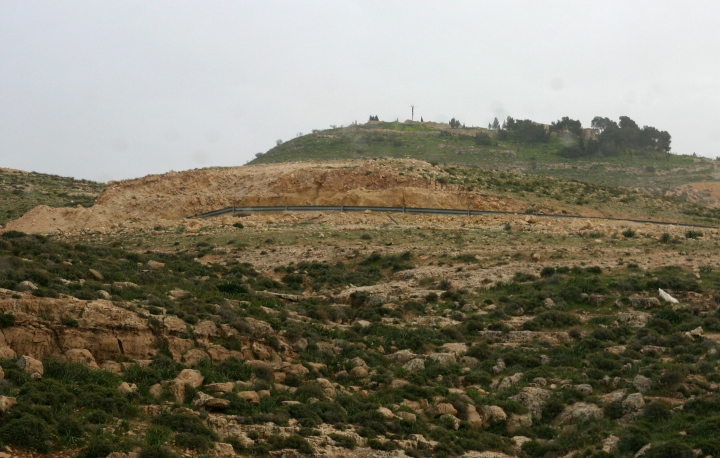
View
of Mount Nebo (through a rain soaked bus window)
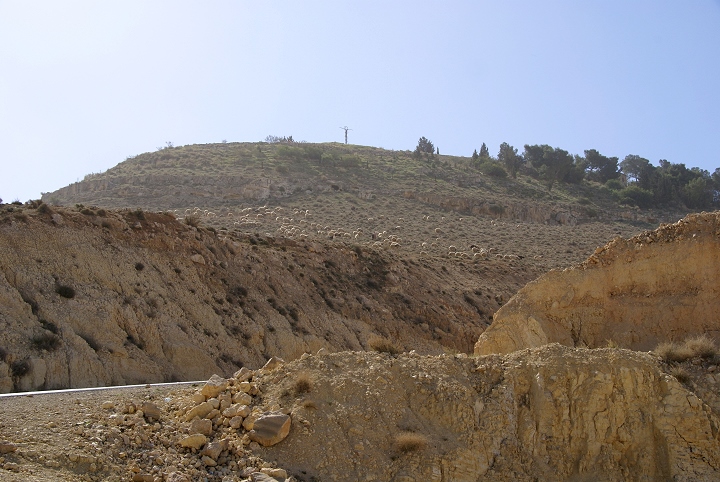
View
of Mount Nebo - final got a sunny day, even sheep grazing on the hillside! |
|
Even though Moses would
not physically enter the Promised Land (until the time of Jesus), God
supernaturally enabled him to see its entirety from atop Mount Nebo.
Deuteronomy 34:1-6 Then
Moses climbed Mount Nebo from the plains of Moab to the top of
Pisgah, across from Jericho. There the Lord showed him the whole land
- from Gilead to Dan, 2 all of Naphtali, the
territory of Ephraim and Manasseh, all the land of Judah as far as
the western sea, 3 the Negev and the whole region from the Valley of
Jericho, the City of Palms, as far as Zoar. 4 Then the Lord said to
him, "This is the land I promised on oath to Abraham, Isaac and
Jacob when I said, 'I will give it to your descendants.' I have let
you see it with your eyes, but you will not cross over into it."
5 And Moses the servant of the Lord died there in Moab, as the Lord
had said. 6 He buried him in Moab, in the valley opposite Beth Peor,
but to this day no one knows where his grave is. (NIV)

Sign
showing distances and direction to Hebron, Bethlehem, Jericho and more.
Sorry
for the cloudy view... it's rained most every time I've been there.
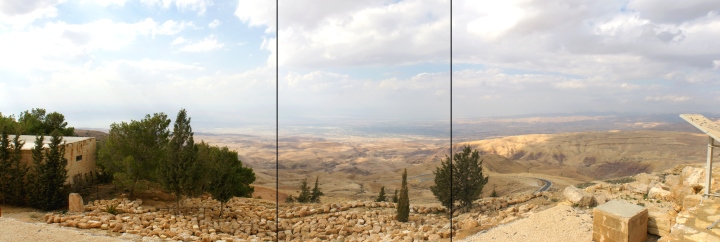
I
finally had a relatively clear day and stiched this panorama. Click
on the photo, or here, for a larger view.
It is important to note
that God buried Moses at an unknown location, in a valley (wadi)
below Mt. Nebo. (Based on the "valley opposite Beth Peor",
it is likely the valley still known as Wadi Ayun Musa, or the Valley
of Moses' Spring. This valley has nothing to do with the Moses'
Spring located in the Sinai). The Israelites had spent many
generations in Egypt, the country that elevated worship of rulers and
colossal monuments to an art form and way of life (i.e. consider Giza,
Saqqara and Memphis). With out a doubt, God
knew that this people, who had quickly fallen into Egyptian style
idolatry at Mount Sinai, would likely do the
same regarding Moses following his death. Imagine, for a moment, the
burial shrine or monument the people would have erected and the
veneration and pilgrimages that would have ensued had the location
been known.

Artwork
at top of Nebo
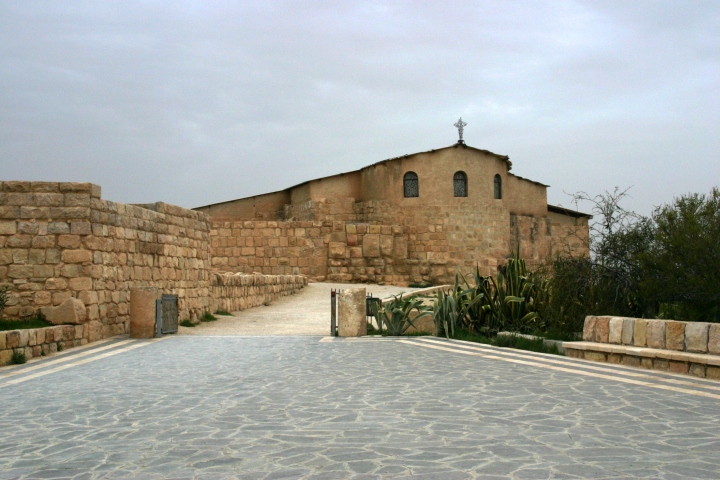
Modern
structure covering ruins of ancient churches
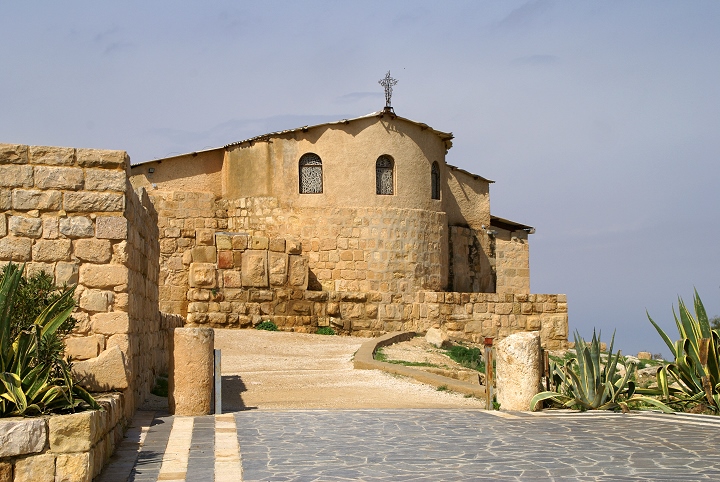
Another
closer view of the new over the old
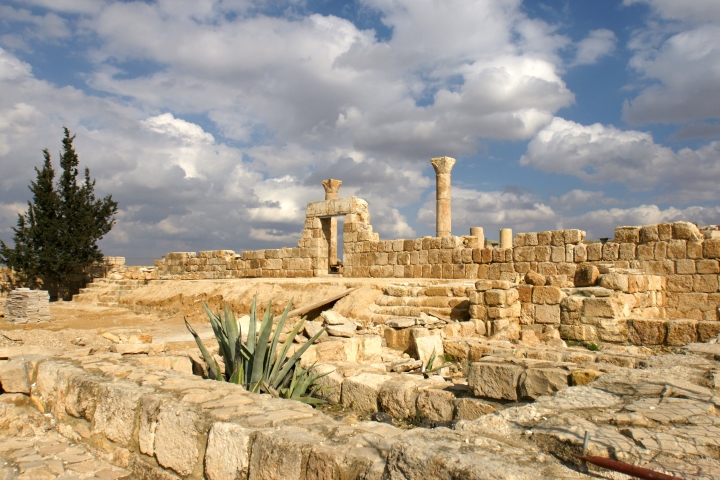
In
2009 the new structure over the ancient ruins was completely removed
(and closed to the public)
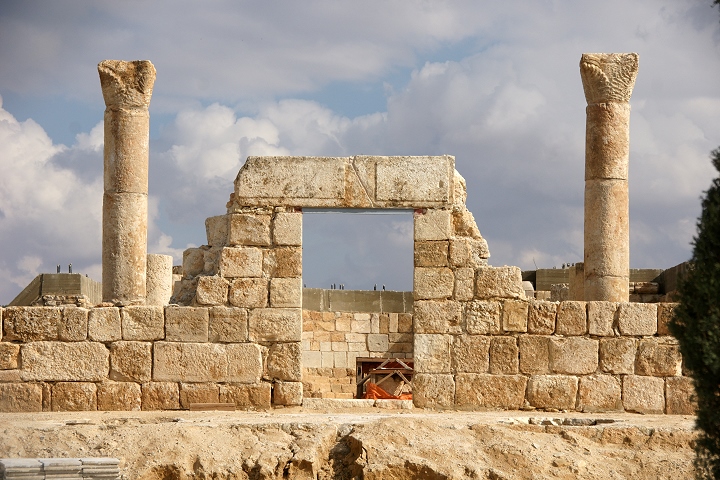
Closer
view of the uncovered ruins (2009)
|
|
By the fourth century,
hermits and monks were perpetuating a fraud, claiming (regardless of
Scriptures) that they knew the location of Moses' burial - the site
of the church atop Nebo.
In Byzantine times,
however, the tomb was pointed out to pilgrims. Noteworthy among those
pilgrims was Etheria (or Egeria), an abbess, and Peter the Iberian, a
bishop. Egeria visited this region toward the end of the 4th cent.
A.D. The hermits of 'Ayun Musa conducted her to a small church on the
top of Mt. Nebo. Near the pulpit of the church a monument, which was
a little higher than the pulpit, attracted her attention. When she
asked what that monument was, she was told that it was the tomb of
Moses. When she protested that according to the Bible no one knew
where that tomb was, she was told that the hermits had this
information from their forebears. Outside the church the hermits
pointed out all the places that were visible from there. Peter the
Iberian visited Mt. Nebo twice in the 5th cent. A.D. He and his
companions were informed that the large church that they saw stood
over the cave in which Moses was buried. This fact had been revealed
to a shepherd from the nearby town of Nebo. He reported his vision to
his fellow citizens, who believed the story and on that account
erected the church there. Around the church the pilgrims saw
extensive monastic buildings. These remained in use until about the
8th cent., when they were abandoned and fell into ruins. (Article on
Mount Nebo, International Standard Bible Encyclopedia, revised
edition, Copyright © 1979 by Wm. B. Eerdmans Publishing Co. All
rights reserved.) [This Encyclopedia also has a good write up of the
many archaeological finds, including Mosaics, uncovered at this site.]
Mount Nebo, from the time
of the Exodus, was also associated with a town called Nebo.
Numbers 32:1-5 The
Reubenites and Gadites, who had very large herds and flocks, saw that
the lands of Jazer and Gilead were suitable for livestock. 2 So they
came to Moses and Eleazar the priest and to the leaders of the
community, and said, 3 "Ataroth, Dibon, Jazer, Nimrah, Heshbon,
Elealeh, Sebam, Nebo and Beon - 4 the land the Lord subdued before
the people of Israel - are suitable for livestock, and your servants
have livestock. 5 If we have found favor in your eyes," they
said, "let this land be given to your servants as our
possession. Do not make us cross the Jordan." (NIV) [Also
Numbers 32:34-38, 33:47; 1 Chronicles 5:8]
Ataroth is identified
with Khirbet 'Attarus, eight miles northwest of Dibon and eight miles
east of the Dead Sea. It is also mentioned in the Mesha stele
inscription (c. 830 BC) as a site built by the Israelites and
inhabited by the tribe of Gad. Dibon (=Diban), the Moabite capital,
is approximately four miles north of the Arnon River and twelve miles
east of the Dead Sea. Nimrah, near modern Tell Nimrin, is in the
northern sector of Transjordan along with Jazer. Heshbon (=Hesban),
on the northwest corner of the Madaba plain (three miles northeast of
Mount Nebo), is said to be the capital of the Amorite king Sihon...
Elealeh (= el-'Al) is located northeast of Heshbon (see Isa 15:4;
16:9; Jer 48:34). Sebam is an unknown site. Nebo has also not been
located, but it is mentioned in the Mesha stele. Beon (=Ma'in, Baal
Meon in Num 32:38) is ten miles southwest of Heshbon. In his victory
stele Mesha (ninth-century king of Moab) claims to have built it.
(Article on Numbers 32:3, IVP Bible Background Commentary: Old
Testament, Copyright © 2000 by John H. Walton, Victor H.
Matthews and Mark W. Chavalas. Published by InterVarsity Press. All
rights reserved.)
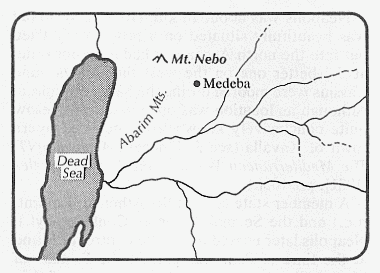
Later prophecies against
Moab, who controlled this territory through much of Old Testament
history, continue to closely associate Nebo and Medeba,
and more generally the area of Dibon. For reference, Mout Nebo is
located approximately 6 miles (10 km) northwest of Medeba
(alt. Madeba).
Isaiah 15:1-2 An oracle
concerning Moab: Ar in Moab is ruined, destroyed in a night! Kir in
Moab is ruined, destroyed in a night! 2 Dibon goes up to its temple,
to its high places to weep; Moab wails over Nebo and Medeba. Every
head is shaved and every beard cut off. (NIV)
Jeremiah 48:1 Concerning
Moab: This is what the Lord Almighty, the God of Israel, says:
"Woe to Nebo , for it will be ruined. Kiriathaim will be
disgraced and captured; the stronghold will be disgraced and
shattered. (NIV) [See also Jeremiah 48:21-23. Kiriathaim is likely
modern el-Qereiyât, 8 km (5 miles) northwest of Dibon]
Mesha, king of Moab
(during the reign of Jehoshaphat in Judah, see 2 Kings 3:4-7),
claimed to have captured Nebo from Israel - killing its residents and
dedicating it to one of the Moabite false gods. This account was
recorded on the Moabite Stone which was found in 1868 at Dhiban,
Jordan (which was ancient Dibon). It provides Mesha's view of the
rebellion mentioned in 2 Kings 3...
And Kemosh said to me,
"Go, take Nebo from Israel." And I went in the night and
fought against it from the daybreak until midday, and I took it and I
killed the whole population: seven thousand male subjects and aliens,
and female subjects, aliens, and servant girls. For I had put it to
the ban for Ashtar Kemosh. (lines 14-17, Mesha Inscription)
|
|
The final word on Mount
Nebo goes to the first century historian, Josephus, who, referring to
the mountain by the name of its range (see Deuteronomy 32:49), aptly
describes it...
Now as soon as they were
come to the mountain called Abarim, (which is a very high mountain,
situate over against Jericho, and one that affords, to such as are
upon it, a prospect of the greatest part of the excellent land of
Canaan,) (Josephus: Antiquities of the Jews 4.8.48)
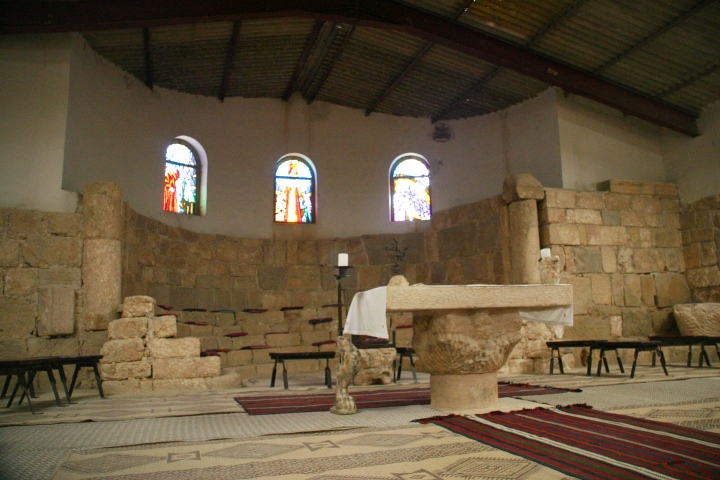
The
altar area of the ancient church
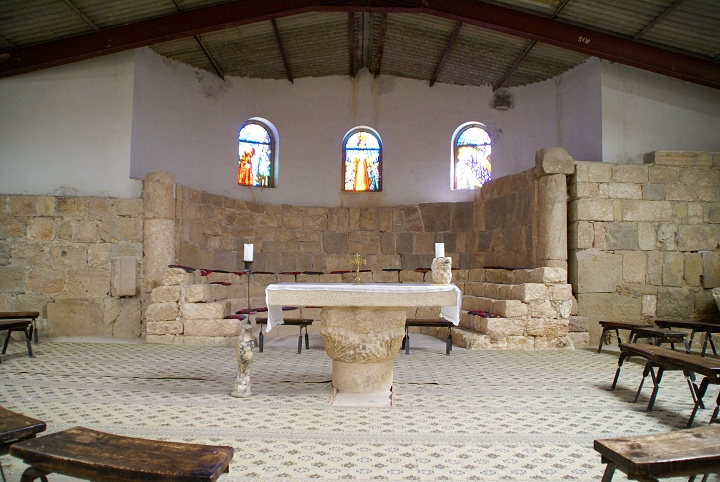
Another
view of the altar area from a few years later
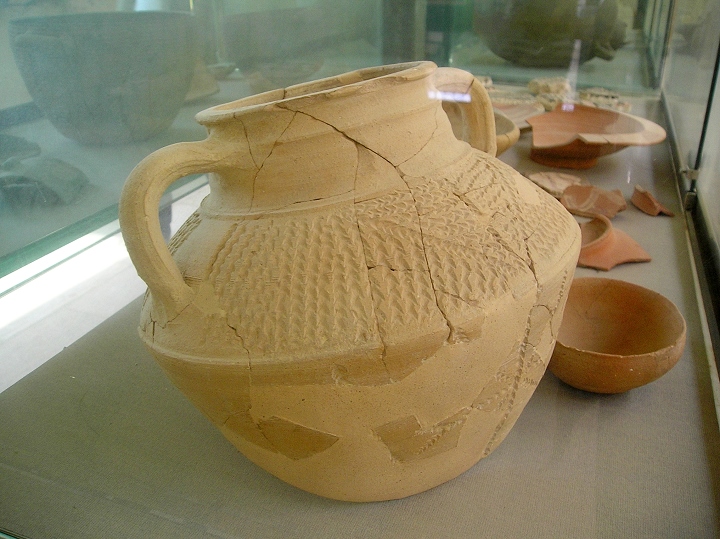
Pottery
Fragments on display at Mt. Nebo
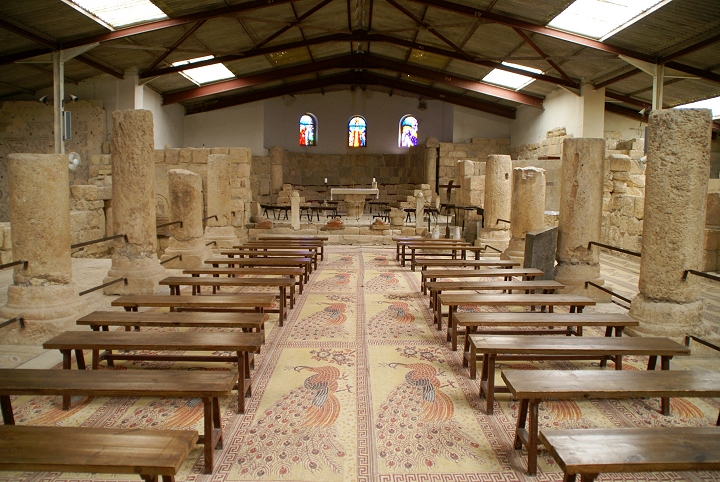
Interior
of the combined structure (new over the ancient ruins) |